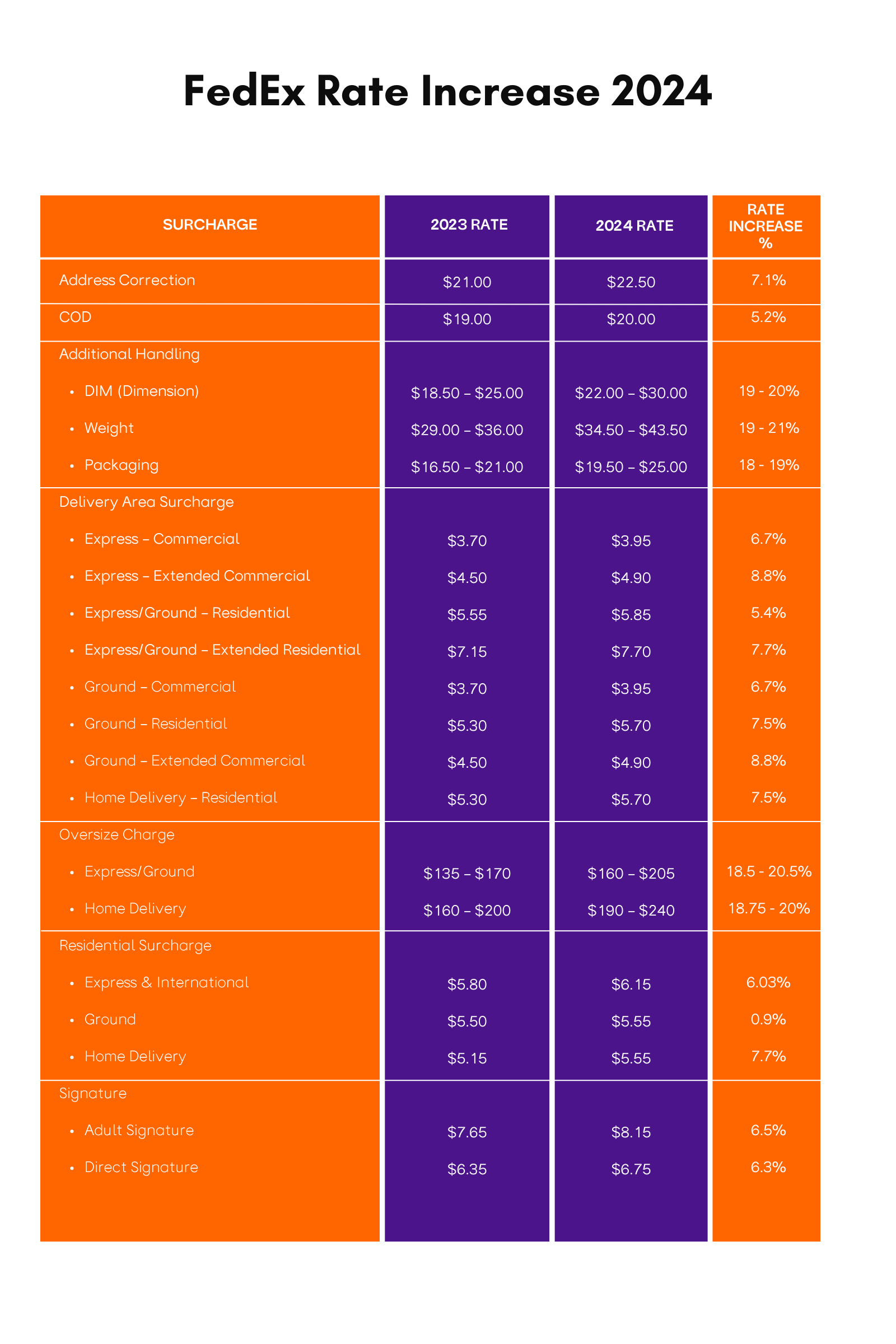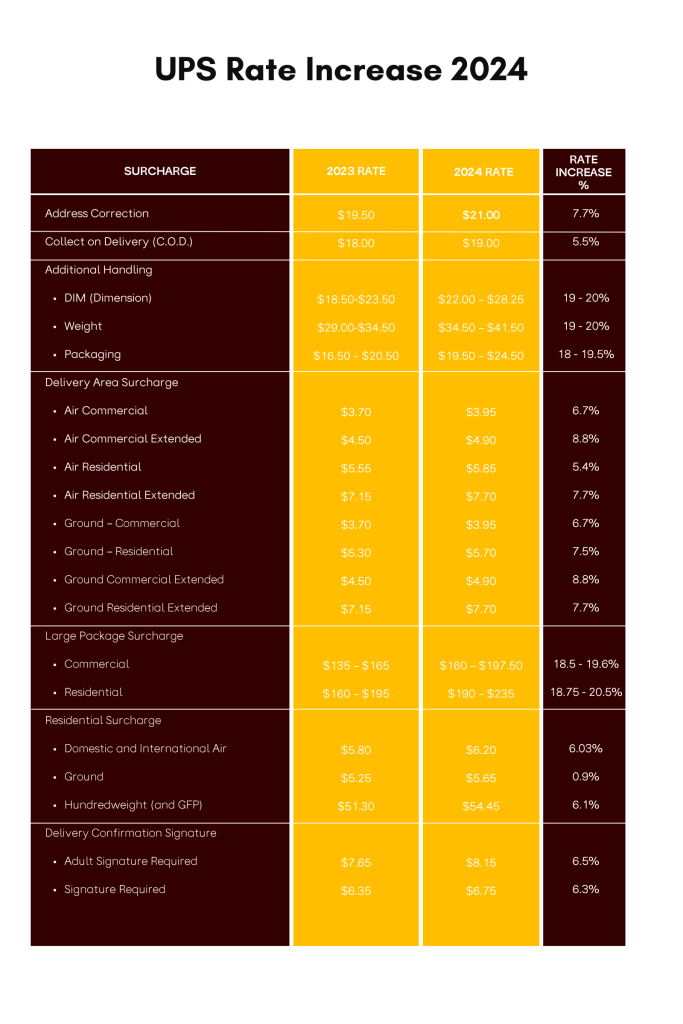Introduction To The Rate Increase By Fedex And Ups In 2024
Counterparts, rivals, competitors — call them what you want. Shipping behemoths FedEx and UPS follow almost identical practices when it comes to services or rate increases by an average of 5.9% YoY. The rates have been identically increasing for 7 years in a row but somehow, they still have the potential to impact e-commerce businesses, particularly SMBs, who operate on a limited bandwidth.
If you’re a part of an SMB business, being aware of this spike by shipping carriers can help you plan out your shipping strategy in advance and put you ahead in your last-mile game. To save you time, we’ve charted out the data for you!
Make sure to read till the end for ways to save on shipping in 2024 and reduce the impact of FedEx & UPS’ General Rate Increase on your business.
Why Are FedEx and UPS Rates Increasing YoY?
A question on the minds of all regular shippers at some point — why do these behemoths, who dominate the U.S. carrier market, with a combined market share of around 70% by revenue keep increasing the rate of their services YoY and burdening several growing e-commerce businesses?
The answer is a no-brainer and it is not just one particular reason but several factors that lead FedEx and UPS to increase the rates of their services each year.
- Inflation – The supply chain and logistics is a very uncertain space that constantly needs fixes and improvements in order to run smoothly and efficiently. A major hindrance to the smooth running of the supply chain is the ever-rising inflation that impacts labor costs, fuel prices, cost of materials and equipment used in shipping operations, leading to higher overall expenses for shipping carriers. To cover these costs and maintain profitability, FedEx and UPS have no choice but to directly pass on these increased costs to customers.
- Increase in demand – While the growth rate has slowed down since the pandemic, e-commerce is still growing. This means, the number of packages being sent out for delivery is on the rise — leading to an increase in demand for infrastructure and resources and thereby impacting costs.
- Strategic investments = There are also frequent investments being done in technology innovations such as fleet maintenance and other areas. Not to forget, as competing businesses, they are prone to focus on profitability and shareholder value and anticipate potential economic fluctuations.
Also, it is important to note that while the average YoY increase is around 5.9%, the actual impact on individual shipments can vary based on service type, destination, and other factors. A breakdown of each carrier’s rate increases will give us a better understanding. Let’s start with the increased rates of FedEx in 2024.
FedEx Rate Increase Details for 2024

Amidst all these rate increases, shippers who opt for FedEx can be slightly relieved due to the fact that the General Rate Increase (GRI) for 2024 is at an average of 5.9%, which is 1% lower than last year’s rate increase.
However, for most shippers, the increase will be more than just 5.9%. For instance, additional handling on oversized packages will increase by about 20%. Therefore, it is crucial to understand how rate increases impact your spending with FedEx. While it’s impossible to take a deep dive on every rate increase, we have managed to cover some key takeaways for all shippers.
- Domestic Express services will see an average increase of 6.25%, with packages shipped through FedEx 2 Day, will see an increase of 6.83%, followed by 2 Day AM at 6.65% and 6.39%. FedEx First Overnight sees lowest increase at 5.46%
- Domestic Ground services as always have different classifications based on different zones and weights, where without surprise — packages shipped to longer distances (zones 5-8) or are heavier (11 pounds or more) see the highest increase at an average of more than 6%.
- FedEx Home Delivery packages are almost similar to Ground packages but will see an additional $5.55 residential surcharge and a rate increase of 6.36%.
- Another often overlooked part of the GRI is the minimum charges that you’ll be paying for the shipment regardless of the weight, distance, and other factors. These minimums ensure profitability for the carriers, especially for smaller packages or shipments to remote areas. Faster shipments such as FedEx Priority Overnight will see an increase of 7.88%, followed by Standard Overnight at 7.50%.
The following FedEx Express and FedEx Ground surcharges will also take effect on January 2024:
- Effective January 1, 2024, FedEx will be increasing customs clearance service fees on imports.
- Effective January 15, 2024, FedEx will assess the Additional Handling Surcharge and Oversize Charge per eligible package for international multi-piece shipments, instead of per shipment. The affected surcharges are the Additional Handling Surcharge (Dimensions, Weight, Packaging, Freight, and Non-Stackable) and the Oversize Charge.
UPS Rate Increase Details for 2024

UPS has followed suit with FedEx almost similarly across the table, starting with dropping the GRI from 6.9% last year.
- Similar to FedEx, UPS has kept the shorter Zones (2-4) lower than the 5.9% increase, while shipping options such as 2nd Day Air and 3 Day Select rates in Zones 5-8 have an increase rate of nearly 8%.
- On the other hand, when it comes to rate increases based on weight, lighter packages (falling below the 1-10 lbs mark) have a maximum increase of 6.65%
- For minimum charges, faster shipping options such as Next Day Air and Next Day Air Saver see the highest increase at 7.91% and 7.51% respectively.
The following UPS surcharges have also been effective since December 26, 2023:
- UPS also introduced an increase in rates for specific Value-Added services and other charges like additional handling rates for both weight and dimension-based packages. For instance, in Zone 2 the Additional Weight Handling rate will go from $29.00 to $34.50, and the Dimensions (Length, Width, Length+Girth) will increase from $18.50 to $22.00 (a rise of 16% in each case).
- Additional Handling fees will also be imposed on international shipments weighing 55 pounds or more. UPS has also stated that when a commercial fee is submitted in connection with a shipment, a fee of up to $5.00 per shipment will be applied to the shipper if the commercial invoice is not provided in digital form using UPS Paperless Invoice services before the processing of the commercial invoice by UPS.
How E-commerce Businesses Can Prepare for the Rate Increase
It is without a doubt that the service rate hikes by FedEx and UPS will definitely impact the spending threshold of all businesses that ship. However, it’s no time to panic! There are definite ways to help mitigate the impact and even turn this tide into an opportunity to reduce shipping costs.
1. Strategies for Mitigating the Impact on Shipping Costs
- Make use of multiple shipping carriers: If you’re a regular shipper with a mid to high shipping volume, don’t just use a single carrier for your shipping needs. Explore alternative carriers and regional shipping providers for competitive rates and service options.
- Negotiate Volume Discounts: Shipping through multiple carriers also creates a bargaining opportunity to negotiate lower rates or better terms with your existing carriers and cut down costs.
- Offer Free Shipping with Minimum Order Thresholds: Encourage customers to ship more by offering free shipping for purchases exceeding a specific amount or multiple products.
- Implement a Flat-Rate Shipping Model: For certain product categories or domestic shipments, consider a flat-rate shipping charge to simplify and potentially control costs.
- Consolidate Shipments: Combine multiple orders into a single shipment whenever possible. This reduces the number of parcels, lowering shipping expenses.
- Explore Cost-Effective Shipping Options: Investigate alternative shipping methods, such as regional carriers or third-party logistics providers (3PLs). These options may offer competitive rates and service quality.
- Understand Dimensional (DIM) Weight Pricing: Familiarize yourself with dimensional weight pricing, which factors in package size. Adjust your packaging and shipping strategies accordingly to avoid unnecessary charges.
2. Considerations for renegotiating shipping contracts
- Evaluate Current Contracts: Carefully review your existing contracts with FedEx and UPS. Identify areas where you can negotiate for improved rates, discounts, and service levels.
- Gather Data and Analysis: Before entering negotiations, prepare data on your shipping volume, service usage, etc to strengthen your bargaining position.
- Contract Flexibility: Seek flexibility in your contracts to adapt to changing needs. Consider shorter contract terms and options to adjust rates as market conditions evolve.
3. Optimizing shipping practices to minimize expenses
- Invest in Shipping Software: Explore shipping software solutions that provide real-time rate comparisons, print labels, and manage orders.
- Leverage Automation: Automate repetitive tasks, such as order processing to not only save time but to minimize labor costs, streamline processes, and reduce manual errors.
- Real-Time Tracking: Implement real-time tracking and monitoring of shipments to identify potential issues early and proactively resolve them, thereby reducing the risk of costly delays or returns.
- Utilize Fulfillment Centers: Strategically locate fulfillment centers closer to major customer bases to reduce shipping distances and potentially qualify for lower zone rates.
- Offer Pick-up Options: Allow customers to pick up their orders at local stores or designated locations to eliminate shipping costs.
How LateShipment.com can help in Navigating the Rate Increase
Check your contract with your shipping carrier, be it FedEx or UPS, and ensure that you haven’t signed any money-back guarantee waiver — as there are a lot more pitfalls than benefits in signing them.
For instance, you may overpay shipping bills by up to 20% by not claiming refunds from shipping carriers for service failures and billing errors.
The Money Back Guarantee policy of shipping carriers promises 100% refunds on shipping charges if a parcel is delayed even by 60 seconds. You can claim refunds for carrier service failures and billing errors.
However, manually claiming refunds from carriers can be both exhaustive and expensive, making it extremely challenging to recover refunds for valid claims before their eligibility window expires.
On the other hand, LateShipment.com automates the process of auditing your shipping invoices regularly and claims refunds for 50+ carrier errors that include late deliveries, incorrect surcharges, lost or damaged packages, and more. By regularly claiming refunds and holding your carrier accountable for your service failures, you can ensure better quality service from them, and save up to 20% on shipping expenses.
That’s not all! LateShipment.com also helps you analyze your carrier’s performance and getting insights on performance lapses such as delays or lost parcels. This will put you in control of shipping rates and help you negotiate for better rates.
You can also take note of our data-rich shipping reports and conclude which carrier works best for which type of delivery/destination/cost/customer/product.
Conclusion
The logistics landscape is dynamic, and the 2024 FedEx and UPS rate increases are just one wave in its constant flow. By proactively planning, making informed decisions, and embracing a culture of continuous optimization, businesses can navigate these changes with confidence, turning every tide into a springboard for growth and success.
Remember, the key lies in flexibility, strategic foresight, and a commitment to delivering exceptional value to your customers. So, raise your sails, adjust your course, and confidently sail towards a prosperous future in the ever-evolving world of shipping.


